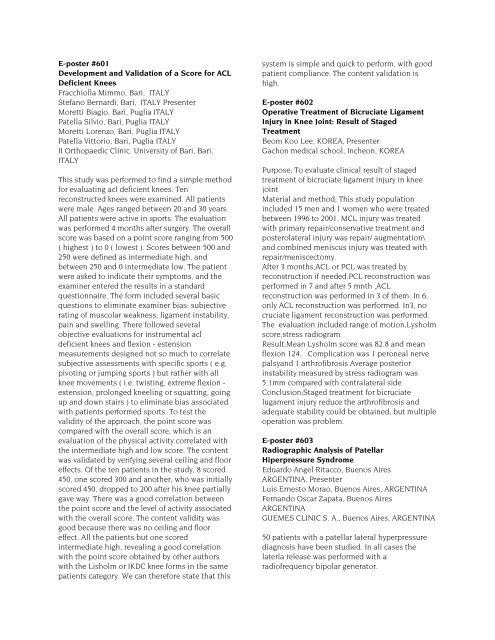POSTER ABSTRACTS - ISAKOS
POSTER ABSTRACTS - ISAKOS
POSTER ABSTRACTS - ISAKOS
Create successful ePaper yourself
Turn your PDF publications into a flip-book with our unique Google optimized e-Paper software.
E-poster #601<br />
Development and Validation of a Score for ACL<br />
Deficient Knees<br />
Fracchiolla Mimmo, Bari, ITALY<br />
Stefano Bernardi, Bari, ITALY Presenter<br />
Moretti Biagio, Bari, Puglia ITALY<br />
Patella Silvio, Bari, Puglia ITALY<br />
Moretti Lorenzo, Bari, Puglia ITALY<br />
Patella Vittorio, Bari, Puglia ITALY<br />
II Orthopaedic Clinic. University of Bari, Bari,<br />
ITALY<br />
This study was performed to find a simple method<br />
for evaluating acl deficient knees. Ten<br />
reconstructed knees were examined. All patients<br />
were male. Ages ranged between 20 and 30 years.<br />
All patients were active in sports. The evaluation<br />
was performed 4 months after surgery. The overall<br />
score was based on a point score ranging from 500<br />
( highest ) to 0 ( lowest ). Scores between 500 and<br />
250 were defined as intermediate high, and<br />
between 250 and 0 intermediate low. The patient<br />
were asked to indicate their symptoms, and the<br />
examiner entered the results in a standard<br />
questionnaire. The form included several basic<br />
questions to eliminate examiner bias: subjective<br />
rating of muscolar weakness; ligament instability,<br />
pain and swelling. There followed several<br />
objective evaluations for instrumental acl<br />
deficient knees and flexion - estension<br />
measurements designed not so much to correlate<br />
subjective assessments with specific sports ( e.g.<br />
pivoting or jumping sports ) but rather with all<br />
knee movements ( i.e. twisting, extreme flexion -<br />
extension, prolonged kneeling or squatting, going<br />
up and down stairs ) to eliminate bias associated<br />
with patients performed sports. To test the<br />
validity of the approach, the point score was<br />
compared with the overall score, which is an<br />
evaluation of the physical activity correlated with<br />
the intermediate high and low score. The content<br />
was validated by verifying several ceiling and floor<br />
effects. Of the ten patients in the study, 8 scored<br />
450, one scored 300 and another, who was initially<br />
scored 450, dropped to 200 after his knee partially<br />
gave way. There was a good correlation between<br />
the point score and the level of activity associated<br />
with the overall score. The content validity was<br />
good because there was no ceiling and floor<br />
effect. All the patients but one scored<br />
intermediate high, revealing a good correlation<br />
with the point score obtained by other authors<br />
with the Lisholm or IKDC knee forms in the same<br />
patients category. We can therefore state that this<br />
system is simple and quick to perform, with good<br />
patient compliance. The content validation is<br />
high.<br />
E-poster #602<br />
Operative Treatment of Bicruciate Ligament<br />
Injury in Knee Joint: Result of Staged<br />
Treatment<br />
Beom Koo Lee, KOREA, Presenter<br />
Gachon medical school, Incheon, KOREA<br />
Purpose; To evaluate clinical result of staged<br />
treatment of bicruciate ligament injury in knee<br />
joint<br />
Material and method; This study population<br />
included 15 men and 1 women who were treated<br />
between 1996 to 2001. MCL injury was treated<br />
with primary repair/conservative treatment and<br />
posterolateral injury was repair/ augmentation\<br />
and combined meniscus injury was treated with<br />
repair/meniscectomy.<br />
After 3 months,ACL or PCL was treated by<br />
reconstruction if needed.PCL reconstruction was<br />
performed in 7 and after 5 mnth ,ACL<br />
reconstruction was performed in 3 of them. In 6,<br />
only ACL reconstruction was performed. In3, no<br />
cruciate ligament reconstruction was performed.<br />
The evaluation included range of motion,Lysholm<br />
score,stress radiogram<br />
Result;Mean Lysholm score was 82.8 and mean<br />
flexion 124. Complication was 1 peroneal nerve<br />
palsyand 1 arthrofibrosis.Average posterior<br />
instability measured by stress radiogram was<br />
5.1mm compared with contralateral side.<br />
Conclusion;Staged treatment for bicruciate<br />
lugament injury reduce the arthrofibrosis and<br />
adequate stability could be obtained, but multiple<br />
operation was problem.<br />
E-poster #603<br />
Radiographic Analysis of Patellar<br />
Hiperpressure Syndrome<br />
Eduardo Angel Ritacco, Buenos Aires<br />
ARGENTINA, Presenter<br />
Luis Ernesto Morao, Buenos Aires, ARGENTINA<br />
Fernando Oscar Zapata, Buenos Aires<br />
ARGENTINA<br />
GUEMES CLINIC S. A., Buenos Aires, ARGENTINA<br />
50 patients with a patellar lateral hyperpressure<br />
diagnosis have been studied. In all cases the<br />
laterla release was performed with a<br />
radiofrequency bipolar generator.
















